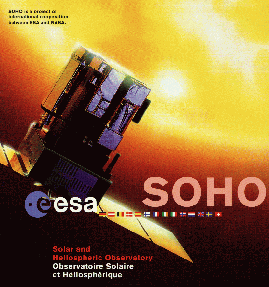Click on image for full size
Image courtesy of NASA
How do Satellites & Spacecraft Monitor Space Weather?
Observations by Earth-orbiting satellites and other spacecraft have revolutionized our understanding of the Sun and space weather in recent years. A host of spacecraft provide a flood of information about the Sun, Earth's magnetosphere and atmosphere, and the heliosphere. Much of this data was unattainable prior to the space age.
Spacecraft that Observe the Sun
Telescopes and other solar observatories in space monitor the Sun and the solar atmosphere. These observatories monitor portions of the electromagnetic spectrum unavailable to ground-based telescopes (such as ultraviolet and X-ray wavelengths) and can observe continuously without interruption by cloudy skies or night. Spacecraft-bourne coronagraphs provide excellent views of the Sun's atmosphere.
Spacecraft that Measure the Solar Wind
The Solar Wind and accompanying Interplanetary Magnetic Field (IMF) flow outward from the Sun to fill interplanetary space. Spacecraft throughout our Solar System make direct measurements of the solar wind and IMF. They record the speed and density of the solar wind, the strength and direction of the IMF, and numerous other traits of these phenomena. Some spacecraft make such observations in the vicinity of Earth, while others measure these traits in far-flung corners of our Solar System (often as part of missions to distant planets, asteroids, or comets).
Spacecraft that Observe Magnetospheres
Some planets, including Earth, have strong magnetic fields that disrupt the solar wind and IMF in their vicinity, generating complex regions called magnetospheres around those planets. Earth-orbiting satellites and probes to other planets measure magnetic field strengths, particle densities, electrical currents, and other traits of the radiation belts, plasmaspheres, and other regions of planetary magnetospheres.
Watching the Aurora from Space
Auroras, the Southern and Northern Lights, are visible from high latitude regions on Earth. Auroral displays are also visible from space, and that perspective can provide valuable insights into those space weather induced lightshows. Astronauts have photographed auroras from low Earth orbit, while satellites in higher orbits can observe entire auroral ovals encircling the poles in a single view. Interplanetary spacecraft and the Hubble Space Telescope have also observed auroras at the poles of other planets!
Keeping an Eye on the Atmosphere
Closer to home, satellites also help monitor the effects of space weather within Earth's atmosphere. The layers of Earth's ionosphere are especially influenced by space weather storms. Satellites, often using radio waves and teamed with ground receiving or transmission stations, probe the ionosphere to see how the charged particles there are influenced by space weather.
Special Orbits for Space Weather Spacecraft
Spacecraft make use of a broad range of specialized orbits to optimize space weather observations of specific types. Some follow polar orbits around the Earth or Sun, some sit at the LaGrange point "upstream" (solar wind-wise) of the Earth, and others trail or precede Earth in its orbit. Earth-orbiting satellites use geosynchronous, polar, and precessing orbits to best position themselves for observing.








